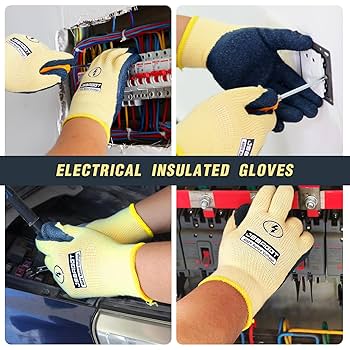When you work with electricity, your safety should never be a question. Electrical safety hand gloves are more than just gear—they are your first line of defense against shocks, burns, and serious injuries.
Imagine how much peace of mind you’d have knowing your hands are fully protected every time you handle electrical equipment. You’ll discover why choosing the right gloves is crucial, how they protect you, and what to look for to keep yourself safe.
Ready to take control of your safety? Keep reading to find out everything you need to know about electrical safety hand gloves.

Credit: www.tilsatec-na.com
Importance Of Electrical Safety Gloves
Electrical safety gloves are essential for anyone working with electrical equipment. They protect hands from dangerous electric currents. Wearing these gloves can save lives and prevent serious injuries. Safety gloves create a barrier between the skin and live wires or electrical parts. Their importance cannot be overstated in workplaces involving electricity.
Preventing Electrical Shocks
Electrical gloves stop electricity from passing through the body. They are made from non-conductive materials like rubber. This feature helps workers avoid shocks that can cause burns or heart problems. Proper gloves reduce the risk of electric shock accidents.
Reducing Injury Risks
Gloves protect against cuts, burns, and abrasions. They add a layer of safety when handling sharp or hot objects. Wearing gloves lowers the chance of serious hand injuries on the job. Workers feel safer and more confident with the right gloves.
Compliance With Safety Standards
Using electrical gloves meets legal safety requirements. Many industries require gloves that pass specific tests. These standards ensure gloves provide enough protection. Following rules helps companies avoid fines and keep workers safe.
Types Of Electrical Safety Gloves
Electrical safety gloves come in various types, each designed to protect you from specific risks when working with electricity. Understanding these types helps you choose the right gloves for your job and avoid accidents. Let’s look at the main categories of electrical safety gloves that professionals rely on every day.
Rubber Insulating Gloves
Rubber insulating gloves are your first line of defense against electrical shocks. They are made from thick rubber that blocks electricity and protects your hands from high voltage. These gloves come in different classes, each rated for a certain voltage level, so you can pick the right one based on your work environment.
These gloves must be tested regularly to ensure they maintain their protective qualities. Have you ever checked your gloves for tiny cracks or wear? Even small damage can make them unsafe.
Leather Protectors
Leather protectors don’t provide insulation but add an extra layer of physical protection over rubber gloves. They protect your rubber insulating gloves from cuts, punctures, and abrasions that could compromise their safety. Using leather protectors extends the life of your rubber gloves and keeps your hands safer during tough tasks.
Think of leather protectors as a shield that preserves the integrity of your insulating gloves. Have you noticed how rough work conditions can wear down your gloves quickly? Leather protectors help with that.
Leather Cover Gloves
Leather cover gloves serve a similar purpose to leather protectors but are designed to be worn over insulating gloves for additional protection. They are typically thicker and more durable, suitable for heavy-duty jobs where your hands face mechanical hazards alongside electrical risks.
These gloves are essential if you handle sharp tools or rough materials while working on electrical installations. Are you prepared for the physical challenges your job throws at your gloves? Leather cover gloves can make a big difference.
Choosing The Right Gloves
Electrical safety hand gloves are your first line of defense when working with electrical equipment. But not all gloves are created equal. Choosing the right pair is crucial for your safety and efficiency on the job.
Assessing Voltage Levels
The first step in selecting the right gloves is understanding the voltage levels you’ll be working with. Electrical gloves are categorized by the maximum voltage they can handle safely. For instance, Class 0 gloves are rated for up to 1,000 volts, while Class 4 gloves can handle up to 36,000 volts.
Always check the voltage rating printed on the glove. Using gloves rated for a lower voltage than required can put your life at risk. If you’re unsure about the voltage levels, consult your equipment specifications or a qualified professional.
Selecting The Proper Class
Once you know the voltage level, select the glove class that matches your needs. Electrical gloves are divided into classes ranging from Class 00 to Class 4. Each class is designed to protect against specific voltage ranges.
For example, Class 00 gloves are ideal for low-voltage tasks like residential electrical repairs. On the other hand, Class 3 or 4 gloves are necessary for high-voltage industrial work. Matching the glove class to your task ensures you stay protected without compromising flexibility.
Considering Glove Size And Fit
Comfort matters just as much as safety when choosing gloves. A glove that’s too tight can restrict your movement, while a loose glove may reduce your grip and precision. Both scenarios can lead to mistakes or accidents.
Measure your hand circumference and length to find the right size. Most manufacturers provide sizing charts to help you choose. Always try on the gloves to ensure a snug yet comfortable fit before making a purchase.
Remember, electrical safety gloves often require an additional leather protector for extra durability. The protector should not compromise the fit of the primary glove. A well-fitted glove offers better control and reduces the risk of accidents.
Testing And Certification
Electrical safety hand gloves are essential for protecting workers from electric shocks. To ensure their reliability, gloves undergo rigorous testing and certification. These processes verify their ability to withstand high voltage and meet industry standards. Regular testing and proper certification ensure workers’ safety in hazardous environments.
Dielectric Testing Procedures
Dielectric testing checks the gloves’ ability to resist electrical currents. This process involves exposing gloves to controlled high voltage. Technicians submerge gloves in water and apply voltage inside and outside. This simulates real-world conditions to identify any potential weaknesses. If gloves fail the test, they are deemed unsafe for use. Only gloves that pass are approved for electrical work.
Industry Certifications
Certified gloves comply with strict safety standards set by organizations. Common certifications include ASTM D120 and IEC 60903. These standards ensure gloves provide adequate insulation and durability. Workers must choose gloves with the correct certification for their specific tasks. Certified gloves enhance trust and reliability in safety equipment.
Frequency Of Testing
Regular testing ensures gloves maintain their protective properties over time. Industry guidelines recommend testing gloves every six months. For gloves used in extreme conditions, testing may occur more frequently. Damaged or heavily worn gloves should undergo immediate testing. Routine checks prevent accidents and ensure ongoing safety for workers.
Proper Use And Maintenance
Using electrical safety hand gloves correctly and keeping them well-maintained can make a huge difference in protecting you from electrical hazards. Gloves that are damaged or dirty might fail when you need them the most. Taking a few minutes to inspect, clean, and store your gloves properly helps ensure they perform as expected every time.
Inspection Before Use
Before you put on your gloves, check them thoroughly. Look for any cracks, holes, or tears that could let electricity through. Even small damages can cause big risks.
Run your fingers gently over the surface to feel for any stiffness or rough spots. These signs may indicate aging or material breakdown. If you spot any defects, don’t take chances—replace the gloves immediately.
Cleaning Methods
Cleaning your gloves helps maintain their flexibility and insulating properties. Use mild soap and warm water to wash them after each use. Avoid harsh chemicals or abrasive scrubbing, as these can weaken the material.
After washing, rinse the gloves well and dry them naturally away from direct heat or sunlight. Have you noticed how some gloves dry faster but feel brittle? That’s a sign they might be damaged by heat exposure.
Storage Tips
Store your gloves in a cool, dry place away from direct sunlight and sharp objects. Rolling them loosely instead of folding prevents creases that can cause cracks over time.
Keep them in a dedicated container or bag to protect from dust and moisture. Have you ever found a glove stuck to something or dried out because it was left exposed? Proper storage avoids these problems and extends glove life.

Credit: www.amazon.com
Common Mistakes To Avoid
Wearing electrical safety hand gloves is crucial for protection. Many users make common mistakes that reduce glove effectiveness. Avoiding these errors ensures safety and extends glove life.
Using Damaged Gloves
Damaged gloves lose their insulating power. Small cuts, holes, or tears can let electricity pass through. Always check gloves for visible damage before use. Discard gloves that show wear or cracks. Using damaged gloves puts users at high risk of electric shock.
Ignoring Expiry Dates
Electrical gloves have a limited lifespan. Over time, the material degrades and becomes less safe. Expired gloves may not protect against high voltage. Check the manufacturing and expiry dates regularly. Replace gloves once they reach their expiry to maintain safety.
Improper Layering Techniques
Layering gloves helps improve protection but must be done correctly. Wearing two gloves of the same type does not add safety. Use a leather glove over an insulating rubber glove for better defense. Avoid mixing incompatible glove types. Proper layering prevents punctures and enhances insulation.
Advancements In Glove Technology
Electrical safety hand gloves have seen major progress in recent years. These improvements help protect workers more effectively. New technologies focus on stronger materials, better fit, and smart features. These changes make gloves safer and easier to wear for long hours.
Innovative Materials
New materials provide higher resistance to electric shocks. Manufacturers use blends of rubber and synthetic fibers. These materials are lighter but still strong. They resist punctures and cuts better than older gloves. This ensures longer use and more reliable protection.
Enhanced Comfort Features
Comfort is key for safety gloves. Modern gloves include breathable fabrics to reduce sweat. Flexible designs allow natural hand movement. Soft inner linings prevent irritation during long use. These features help workers stay focused and safe.
Smart Gloves With Sensors
Some gloves now include built-in sensors. These sensors detect voltage and temperature changes. They alert users to potential hazards quickly. Smart gloves can connect to mobile apps for real-time monitoring. This technology adds a new layer of safety on the job.

Credit: www.amazon.com
Glove Safety In Different Industries
Electrical safety hand gloves are essential in protecting workers from potential hazards. Different industries have unique safety needs, and choosing the right gloves can make all the difference. Let’s look at how glove safety is applied across various fields.
Construction And Electrical Work
In construction and electrical work, gloves are a must to prevent electric shocks and burns. Workers often deal with high-voltage equipment and exposed wiring. Insulated gloves designed for electrical protection should be prioritized.
Have you ever noticed workers checking their gloves before starting tasks? This is a critical step. Inspecting for tears or wear ensures maximum safety, especially in environments prone to accidents.
Utility And Maintenance Services
Utility workers and maintenance crews face diverse challenges daily. From repairing power lines to handling electrical panels, gloves provide the first line of defense. They shield against live wires and unexpected surges.
Utility gloves often combine durability with dexterity. Why? Because workers must handle small tools and delicate parts without compromising safety. Always ensure gloves meet industry standards for voltage protection.
Manufacturing And Laboratories
Manufacturing plants and laboratories often deal with sensitive electrical systems and chemical interactions. In these settings, gloves serve dual purposes: electrical safety and chemical resistance.
Imagine working with circuits while also handling corrosive substances. Gloves designed for multi-protection are vital here. Choose gloves that can withstand both electrical hazards and chemical exposure to stay safe.
Frequently Asked Questions
What Are Electrical Safety Hand Gloves Used For?
Electrical safety hand gloves protect workers from electrical shocks while handling live wires, equipment, or high-voltage systems.
How To Choose The Right Electrical Safety Gloves?
Select gloves based on voltage rating, material quality, and safety standards. Ensure proper fit for optimal protection and dexterity.
Do Electrical Gloves Expire Or Need Regular Testing?
Yes, electrical gloves expire. They require regular testing every 6 months to ensure insulation and safety standards.
Can Electrical Gloves Be Reused After Exposure To Electricity?
No, electrical gloves exposed to electricity should not be reused. Always replace damaged or compromised gloves immediately.
Conclusion
Electrical safety hand gloves protect you from electric shocks and injuries. They provide a strong barrier between your skin and live wires. Always choose gloves that fit well and meet safety standards. Using gloves can save your life during electrical work.
Keep them clean and check for damage before use. Safety is simple with the right gloves. Stay safe, stay smart.








